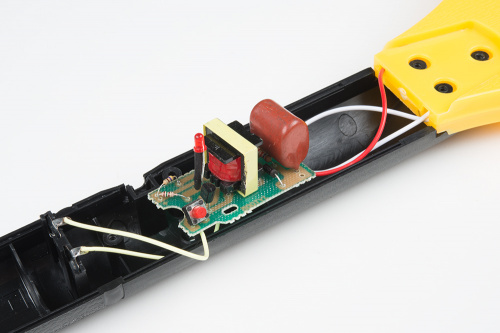If you've been following the antics of the SparkFun team for any amount of time, you'll know that we're a slightly sadistic bunch. We love each other, but we also love to be a little mean to each other sometimes. Classic office shenanigans like electro-Jenga, the horn box and Tim's finicky monitor have brought a great deal of joy to our surroundings, and in the spirit of these past glories I present to you "The Hot Seat."
The Hot Seat uses our new conductive adhesive copper tape and a hacked electronic fly swatter to deliver a shock to the back of the player's legs when they fail to maintain a steady hand on the wire maze attached to the chair arm. That, of course, makes them worse at the game ... and so on.
The shock is on the order of hundreds of volts; the longer your failure is (i.e., the longer the wand touches the course), the worse the shock. The position of the electrodes makes it unlikely that anything fragile will be affected; the current path is short and through skin only.
If you're interested in how this thing works, read on. Otherwise, just watch the video, again and again, and remember that, since every person in it is a volunteer, you can take as much pleasure in our discomfort as you like.
Now, on to the gritty details. I'm fascinated by things like this fly swatter. Built and shipped from China to be sold for $4 ... it's amazing! I had a fair idea of what would be going on inside, but let's take a look.
As you can see, the board is really simple. Single-sided unmasked unsilkscreened, with only a handful of components. Here's the schematic as I've reverse-documented it.
You can see that the board is basically just a BJT switch that allows a large dump of current through the low-voltage windings of the transformer. On the high-voltage side, we expect a proportionally smaller current to flow (the "turns" labeled on the schematic are, in fact, the ratio of resistance of one set of windings to the other; I'm making the assumption that the wire gauges are the same) but to see a proportionally higher voltage develop across the capacitor. There's a blocking diode to prevent C1 from discharging back across the coil when a steady state is reached on the LV side.
The circuit is really simple, which I'd expect for a $4 item. It's kind of cheesy (the transistor gets pretty hot if you hold down the button too long), and the construction is shoddy, but it works.
I've played around with this a bit; replacing the button (or rather, paralleling the button) with any other break/make circuit works fine for triggering the device. I've used an NMOSFET as a switch for a microcontroller-based device with this, to great effect.
We had a lot of fun making the video, and the project; I hope you enjoyed watching!








Almost embarrassed to say that I enjoyed it....
I wonder how long the line was outside the HR department the next day? LOL!
Keeping the 'FUN' in Sparkfun, loved it!!
I know this is quite an old post, but I have a few questions about this circuit (I want to build my own from scratch for educational purposes...and some shocking fun with consenting friends).
Could anyone explain to me what L1 and L3 are? I don't see them in the circuit (the actual photo of the board). And what values would I choose for the Transformer and the capacitor? I disassembled a swatter I had lying around and measured the capacitor. It seems to have 15nF, voltage rating is unknown. The swatter is outputting something around 1.5kV (at least that's what I remember the packaging said).
So...what values would I need? Or better yet: how can I calculate what values I need for a given output (including safety levels, of course)?
Thanks :)
I was inspired to do a build of this project as a carnival game for a neighborhood party. Version 1.0 had the victim stand on two copper traces which would deliver the zap. Unfortunately, the soles of your feet are pretty tough, and couldn't even feel the ~850V. Version 1.1 involved holding a handle with your left hand while trying to do the puzzle with your right. This worked great.
Behold, The Shocker
I love the bus bar and knife switch usage! Very well made. Thanks for sharing!
Is the current entering one hand, moving across the chest and out the other hand?
Nope. All the high voltage passes between two wires on the handle for the left hand. Not trying to kill anyone here...just cause slight discomfort.
No common grounds?
Nope. There are two fully isolated circuits connected by a relay. The "game" side is connected to the 4-AA battery source. When the player connects the circuit (with their right hand), then it activates the relay. The relay connects the 2-D batteries to the bug zapper which releases the charge to the left hand. The big-old knife switch is a highly visible break in the positive side of the D-battery power source to the relay (and ultimately to the bug zapper).
This is an interesting way of doing it...I considered this, using a relay to discharge the capacitor into the subject, and decided against it because I didn't like the idea of the charge being present all the time.
The upshot is, you can bulk-discharge the thing from a higher voltage in a shorter time. With my method, the longer the error, the longer and stronger the shock- short glitch contacts do nearly nothing.
I may experiment with a relay for v2.0. If I ever get there....
Looks like an episode of "Buck Wild". Enginursday and Friday product posts used to be a source of interesting, educational topics and new products. Topics for all ages to read and pick new projects to experiment and learn from. Now it's DIY sadistic, idiotic shock games and how to inject RF tags under your skin. Shame on you Sparkfun staff.
Have you read like ANY of Mike's other posts? Lighten up, no one forces you to read or watch.
The prodigal son returns to comment!
You're right Casey, nor does anyone force me to be a Sparkfun customer.
I'm afraid you're right, we can't force anyone to be a customer and we'd never want to because building a healthy, positive online (or offline) community is about letting people self-select and self-identify based on their preferences.
But wherever you end up, please remember that there are real people and stories behind every blog post and every project and almost none of them have intent to harm you or bore you or otherwise cause offense. Mike was really excited about this project, because it is stupid and it was a welcome break from hard engineering. We also thought it was a really good example of how you can have a lot of fun and get big effects by using inexpensive consumer goods in non-conventional ways. Mike and I spent a good chunk of time after hours just hanging out at the office and talking about the project, getting everyone together to shoot the video was nothing but a fun time (as the video no doubt conveys) and at the end of the day it felt like a callback to SparkFun's prankster days (a few examples are in the blog post) which made our videographer, Gregg, feel really good about it. Also, Mike got to reverse-document a piece of consumer electronics and talk a little bit about how the circuit works.
All of this is to say that you are of course entitled to your own opinion, and you don't need to like our content or buy our products, but you're not entitled to shame our staff for work that we're all proud of and had fun doing. You'll get very little mileage out of people that way.
If you choose to hang around, and we really do hope you will (because who hasn't felt this way about a website that they're fond of before? I know that I have) we're sure that you'll find more stuff that you're interested in. Sure, this is an eclectic blog and not everything here will be interesting or even appropriate for everyone. But what we can promise is that it won't ever be vulgar and that it will always be motivated by an interest in how things work, how things are made and how to have fun with science and technology... even if sometimes that fun is a little dangerous.
If we don't hear from you again: Happy hacking, Kevin, and let us know what you're hacking on anytime, we love a good project :) We'd like to think that your interest in all-ages education and nurturing curiosity are right in line with ours and it's nice to know that even the customers that may not agree with our voice or our sense of humor at least share that common attitude.
boom